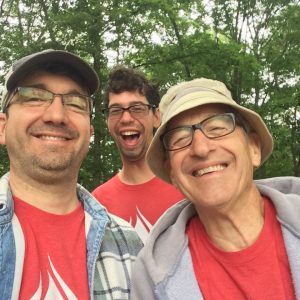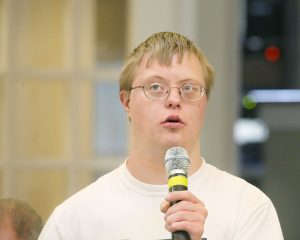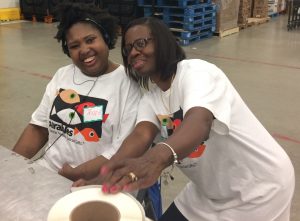Creating Trauma-Informed, Welcoming Spaces For All

Ben with his dad and grandfather at camp.
By Jeanne Davies, Executive Director, Anabaptist Disabilities Network
When I was a pastor, I learned we had a few young people with autism in our youth group. In order to begin creating an environment that felt more comfortable, I provided a big basket of fidgets on the table in the center of the room. I expected that youth with autism would use them to help reduce anxiety and increase focus. What I didn’t expect was that everybody in the room would enjoy using them.
At our national youth conference, I created a sensory room so anyone who felt overwhelmed by the crowds, the social demands, and the stimulus of the conference could take a break and color, do prayer activities, work on a puzzle, or simply rest in a room that was quiet with low, warm lighting. Again, a diverse group of people made use of that room. One exhausted conference leader simply came in to lay on the floor with some pillows and take a nap. It turns out that when we make spaces more welcoming and nurturing for people with disabilities, we make spaces that are more welcoming and nurturing for all.
In order to create welcoming, comfortable environments, we must create spaces that are trauma-informed. People with disabilities experience a high incidence of trauma. And trauma itself can cause impairment or disability. We now know that the prevalence of trauma generally in our communities is much higher than we would have believed it to be. We all need trauma-informed communities and our faith communities are no exception.

Jonah leading in prayer.
Unfortunately, religious organizations were exempted from the Americans with Disabilities Act when it was created in 1990. Communities of faith have therefore been slow to make the changes that would make their facilities more accessible to people with disabilities. This includes some basic physical accommodations such as wheelchair ramps, automatic doors, accessible bathrooms, and elevators. But it also includes making accommodations for those with intellectual or developmental disabilities, mental illness, or other disabilities that create barriers to full participation in the life of faith communities.
Religious organizations should be leading in the effort to create communities that include people with diverse impairments and abilities. Who are we excluding from community? We often do this passively by simply not providing the supports they need for access – whether those are physical, social, emotional, or relational. It is good for us to examine our own communities and ask ourselves who isn’t there and why they might not be present. Have we unwittingly created barriers that prevent them from full participation?

Jhanea and her grandmother on a summer service trip.
Access and inclusion are not enough. What people with disabilities need is a place where they belong. Eric Carter writes, “Belonging is rooted in relationships. Having people in our lives who know us, like us, accept us, need us, miss us, and love us is at the heart of our well-being. The same is true for individuals with significant disabilities. Their need for friendships and other supportive peer relationships is a universal need, one grounded in the core belief that humans were created for community.” When we create communities in which people with disabilities belong, we are likely creating communities that feel more welcoming to all people. As Dr. Carter writes, “Belonging is not a special need, it is a universal need.”[i]
Part of belonging and full participation in a faith community is the affirmation and the employment of spiritual gifts. The gifts of people with intellectual and developmental disabilities often are unrecognized and under-employed. When we do not embrace the spiritual gifts of those who are disabled, it is not only people with disabilities who suffer. The whole community suffers because of the lack of their participation and contribution. The community of faith can be a primary place where the gifts of those with disabilities are appreciated and help us all grow spiritually.
I now serve as executive director for the Anabaptist Disabilities Network (ADN). ADN was created in 2002 to provide resources and advocacy from an Anabaptist Christian perspective to families and persons living with mental illness and other disabilities. Our mission is to connect with and support people who have disabilities, families, and faith communities to create a culture of belonging for everybody. We believe that faith communities are transformed when individuals with disabilities and their God-given gifts and experiences enjoy full inclusion. Although we are rooted in the Anabaptist tradition, our resources are available to faith communities and people of any tradition.
You can start thinking about welcoming those with disabilities in your congregation by:
- wondering how you might better include people who are already a part of your community. For example, do you have large-print worship materials? Do you have an audio loop that feeds from your sound system directly into hearing aids?
- considering who isn’t there and why that might be. What might make your faith community more accessible, welcoming, and comfortable? Can a wheelchair user enter the bathroom? Can they reach the sink to wash their hands?
- doing an assessment of your congregation’s accessibility using a survey tool, and then take one step at a time to make some changes.
- finding out what resources your denomination or tradition has for congregations that want to be more welcoming to people with disabilities.
May we all learn together and encourage one another as we create faith communities of healing that embrace everybody, especially those who have been left out or left behind.
Resources
- Anabaptist Disabilities Network www.anabaptistdisabilitiesnetwork.org
- Connections newsletter on disability and trauma https://www.anabaptistdisabilitiesnetwork.org/Newsletter/Pages/2019/Connections-November-2019.aspx
- Making Church Accessible to All: Including disabled people in church life by Tony Phelps-Jones
- Including People with Disabilities in Faith Communities by Erik W. Carter
- Amplifying Our Witness: Giving voice to adolescents with developmental disabilities by Benjamin T. Conner
- Helping Kids Include Kids with Disabilities by Barbara J. Newman
- From Longing to Belonging: A practical guide to Including People with Disabilities and Mental Health Conditions in Your Faith Community by Shelly Christiansen
[i] Erik W Carter, “A Place of Belonging: Including Individuals with Significant Disabilities in Faith Communities,” Inclusive Practices, Sage Publications on behalf of TASH, 2021.



